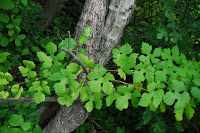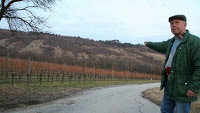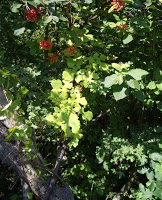The press are reporting that an extremely rare vine in St  Georgener, Eisenstadt, Austria – thought to be over 500 years old – has been vandalized possibly beyond the point of revival.
Georgener, Eisenstadt, Austria – thought to be over 500 years old – has been vandalized possibly beyond the point of revival.
This vine is of great importance as it is the previously unknown father of Grüner Veltliner – and what’s more it is the only one in existence.
The vine was discovered in 2000, by the village historian Michael Leberl. Leberl had heard of this old aromatic vine as a child and researched it as an adult – finally being led to its approximate location by a village elder.
The vine had survived the ravages of phylloxera and war hidden among dense under brush on the Austrian hillside known as the Reid Cattle Pasture.
Records dating  back to 1570 show that this pasture was known to have been a vineyard in the Middle Ages, but it had been used for cattle up until 1950. It’s thought that prickly bushes protected the vine from the grazing cattle.
back to 1570 show that this pasture was known to have been a vineyard in the Middle Ages, but it had been used for cattle up until 1950. It’s thought that prickly bushes protected the vine from the grazing cattle.
Leberl took samples of vine in 2005 and these were analysed at the Federal Research Institute for Wine and Fruit Growing in Klosterneuburg. Genetic analysis in the following years by Ferdinand Regner caused a sensation amongst oenologists and scientists alike as Regner was able to determine that the vine is a parent to Grüner Veltliner, the other parent being Traminer.
was able to determine that the vine is a parent to Grüner Veltliner, the other parent being Traminer.
It is thought that the vine could have been the Grünmuskateller (Green Muscat) which has since disappeared.
The vine has now been named St. Georgener Rebe (Saint George Vine). An experts’ certificate issued in 2009 valued the vine at more than 100,000 euros, or about $136,000.
The vine was very weakened thanks to the overgrowth and had not borne grapes for years. Plans exist to bring the variety into experimental cultivation in order to assess its viticultural properties.
The association hoped to plant a vineyard on the original locatio n, possibly with other old varieties of their region as well as the St. Georgener Rebe.
n, possibly with other old varieties of their region as well as the St. Georgener Rebe.
However last week the vine was found chopped to pieces by vandals — and Leberl was near tears as he told state broadcaster ORF of his sad discovery:
“What was he trying to prove?” asked Michael Leberl of the person – or persons – who destroyed the vine. “I am speechless.”
Initial repor ts said the grapevine was destroyed but a local newspaper later cited unnamed village officials as saying it was so severely damaged that it was unclear whether it would survive.
ts said the grapevine was destroyed but a local newspaper later cited unnamed village officials as saying it was so severely damaged that it was unclear whether it would survive.
Some cuttings taken from the St. Georgener Rebe do exist in 3 different sites in Austria so there is a little hope that all is not lost.


